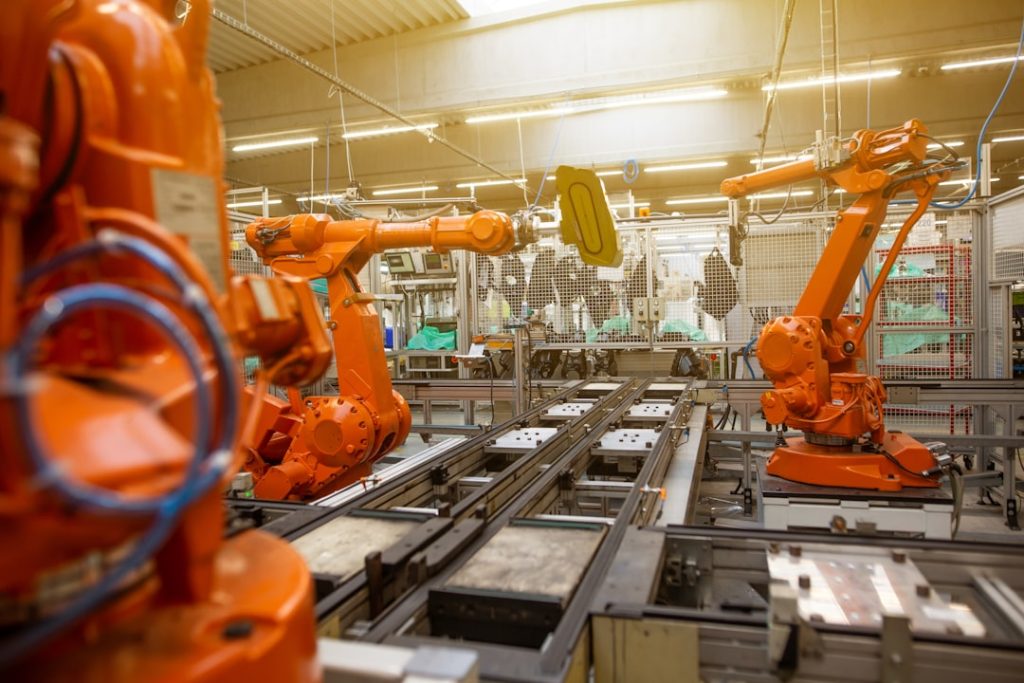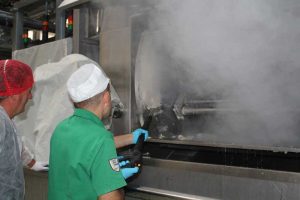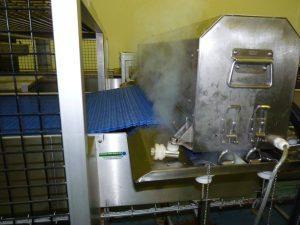One of the most effective methods for cleaning conveyor belts is using steam vapour cleaning machines. These machines use high-temperature steam to break down dirt and grime, making it easier to remove them from the surface of the conveyor belt. There are several benefits to using steam vapour cleaning machines for conveyor belts.
Firstly, steam vapour cleaning machines are highly effective in removing dirt and grime from conveyor belts. The high-temperature steam can penetrate deep into the surface of the belt, loosening and dissolving dirt particles. This makes it easier to remove them with minimal effort. Steam vapour cleaning machines can effectively clean even the toughest stains and residues, leaving the conveyor belt looking clean and pristine.
Secondly, steam vapour cleaning machines are eco-friendly. They use only water and heat to clean the conveyor belt, without the need for harsh chemicals or detergents. This not only reduces the environmental impact but also eliminates the risk of chemical residues being left behind on the belt. Steam vapour cleaning machines are a sustainable and environmentally friendly option for maintaining clean conveyor belts.
Lastly, steam vapour cleaning machines have the added benefit of sanitizing surfaces. The high-temperature steam kills bacteria, viruses, and other pathogens, ensuring that the conveyor belt is not only clean but also hygienic. This is particularly important in industries such as food processing, where maintaining a high level of cleanliness and hygiene is essential.
How Steam Vapour Cleaning Machines Work
Steam vapour cleaning machines work by using high-temperature steam to break down dirt and grime on the surface of the conveyor belt. The machines heat water to a high temperature, typically around 120 degrees Celsius, creating steam. This steam is then directed onto the surface of the conveyor belt using a nozzle or brush attachment.
The high-temperature steam softens and loosens dirt particles, making them easier to remove. The steam also kills bacteria and other pathogens, sanitizing the surface of the conveyor belt. Once the dirt and grime have been loosened, they can be wiped away using a cloth or vacuumed up using a suction attachment.
Steam vapour cleaning machines are highly effective in removing even the toughest stains and residues from conveyor belts. The high-temperature steam breaks down dirt particles at a molecular level, making it easier to remove them from the surface of the belt. This ensures that the conveyor belt is not only clean but also free from harmful contaminants.
Types of Steam Vapour Cleaning Machines for Conveyor Belts
There are several types of steam vapour cleaning machines available for cleaning conveyor belts. The type of machine you choose will depend on the size and type of conveyor belt you need to clean, as well as your specific cleaning requirements.
Handheld steam cleaners are small and portable machines that are ideal for cleaning small sections of conveyor belts or hard-to-reach areas. These machines are lightweight and easy to use, making them suitable for spot cleaning or regular maintenance tasks.
Steam mops are another type of steam vapour cleaning machine that can be used for cleaning conveyor belts. These machines have a mop-like attachment that can be used to steam clean larger sections of the belt. Steam mops are easy to maneuver and can cover a larger area in a shorter amount of time compared to handheld steam cleaners.
For larger conveyor belts or industrial settings, industrial steam cleaners are the most suitable option. These machines are designed for heavy-duty cleaning and can generate high-temperature steam at a consistent rate. Industrial steam cleaners often come with a range of attachments and accessories, allowing for versatile cleaning options.
Advantages of Automatic Conveyor Belt Steam Vacuum Systems
| Type of Steam Vapour Cleaning Machine | Features | Benefits |
|---|---|---|
| Continuous Belt Cleaning System | Automated cleaning process, adjustable steam pressure and temperature, chemical injection system | Efficient cleaning, reduced labour costs, improved hygiene, reduced water and chemical usage |
| Portable Steam Cleaner | Lightweight and compact, adjustable steam pressure and temperature, various nozzle attachments | Easy to manoeuvre, versatile cleaning, reduced water and chemical usage |
| Conveyor Belt Cleaning System | Automated cleaning process, adjustable steam pressure and temperature, chemical injection system, high-temperature steam | Efficient cleaning, improved hygiene, reduced water and chemical usage, reduced downtime for cleaning |
Automatic conveyor belt steam vacuum systems offer several advantages over other types of cleaning systems. These systems are designed to clean large areas quickly and efficiently, making them ideal for industrial settings or businesses with high-volume conveyor belts.
One of the main advantages of automatic conveyor belt steam vacuum systems is their ability to clean large areas quickly. These systems are equipped with a wide cleaning path and powerful suction, allowing them to cover a large surface area in a short amount of time. This is particularly beneficial for businesses that have long conveyor belts or need to clean multiple belts in a short period.
Another advantage of automatic conveyor belt steam vacuum systems is their efficiency. These systems combine the power of steam and vacuum suction to effectively clean and dry the conveyor belt in one pass. The high-temperature steam breaks down dirt and grime, while the vacuum suction removes the loosened particles, leaving the belt clean and dry. This eliminates the need for additional drying time or manual wiping, saving both time and effort.
Automatic conveyor belt steam vacuum systems also offer convenience and ease of use. These systems are typically self-propelled, meaning they can move along the length of the conveyor belt without requiring manual pushing or pulling. This allows operators to focus on other tasks while the system cleans the belt automatically. Additionally, these systems often come with adjustable settings and controls, allowing operators to customize the cleaning process to suit their specific needs.
How Automatic Conveyor Belt Steam Vacuum Systems Work
Automatic conveyor belt steam vacuum systems work by combining the power of steam and vacuum suction to clean and dry the conveyor belt. These systems are typically self-propelled and can move along the length of the belt automatically.
The system starts by generating high-temperature steam, which is then directed onto the surface of the conveyor belt using a nozzle or brush attachment. The steam softens and loosens dirt particles, making them easier to remove. The system then uses powerful vacuum suction to remove the loosened dirt and grime from the surface of the belt.
The combination of steam and vacuum suction ensures that the conveyor belt is not only clean but also dry. This eliminates the need for additional drying time or manual wiping, saving both time and effort. Automatic conveyor belt steam vacuum systems are highly efficient and can clean large areas quickly, making them ideal for industrial settings or businesses with high-volume conveyor belts.
Maintenance Tips for Conveyor Belt Cleaning Systems

To ensure the longevity and effectiveness of your conveyor belt cleaning system, it is important to follow proper maintenance procedures. Regular cleaning and inspection, proper storage, and routine maintenance are key to keeping your system in optimal condition.
Firstly, regular cleaning and inspection of your conveyor belt cleaning system is essential. This includes cleaning the machine after each use to remove any dirt or debris that may have accumulated during operation. It is also important to inspect the machine for any signs of damage or wear and tear, such as loose or damaged parts. Regular cleaning and inspection will help identify any potential issues early on and prevent further damage or malfunctions.
Proper storage of your conveyor belt cleaning system is also important. When not in use, the machine should be stored in a clean and dry area, away from direct sunlight or extreme temperatures. It is also advisable to cover the machine with a protective cover to prevent dust or debris from entering the system. Proper storage will help prolong the life of your conveyor belt cleaning system and ensure that it is ready for use when needed.
Routine maintenance is another important aspect of maintaining your conveyor belt cleaning system. This includes regular servicing and maintenance checks to ensure that all components are in good working order. It is recommended to follow the manufacturer’s guidelines for maintenance and servicing, as they will provide specific instructions for your particular machine. Routine maintenance will help prevent breakdowns or malfunctions and ensure that your conveyor belt cleaning system operates at its best.
Common Problems with Conveyor Belt Cleaning Systems and How to Fix Them
Despite proper maintenance and care, conveyor belt cleaning systems can sometimes experience problems or malfunctions. It is important to be aware of common issues that can occur and know how to troubleshoot and fix them.
One common problem with conveyor belt cleaning systems is clogs or blockages in the steam or vacuum lines. This can occur if dirt or debris gets trapped in the lines, preventing the steam or suction from flowing properly. To fix this issue, it is important to first turn off the machine and disconnect it from the power source. Then, carefully inspect the lines for any signs of clogs or blockages. If a clog is found, it can be cleared by using a small brush or compressed air to remove the debris. Once the lines are clear, the machine can be reconnected and tested to ensure proper operation.
Another common problem is leaks in the steam or vacuum lines. Leaks can occur if there are loose connections or damaged seals in the system. To fix this issue, it is important to first turn off the machine and disconnect it from the power source. Then, carefully inspect the lines for any signs of leaks, such as water or steam escaping from the connections. If a leak is found, it may be necessary to tighten the connections or replace damaged seals. Once the leaks are fixed, the machine can be reconnected and tested to ensure proper operation.
Malfunctions or errors in the control panel or settings are also common issues with conveyor belt cleaning systems. This can occur if there is a problem with the electrical components or if the settings are not properly calibrated. To fix this issue, it is important to first turn off the machine and disconnect it from the power source. Then, carefully inspect the control panel for any error messages or indicators. If an error message is displayed, consult the user manual or contact the manufacturer for troubleshooting steps. If the settings need to be recalibrated, follow the manufacturer’s instructions for adjusting the settings. Once the issue is resolved, the machine can be reconnected and tested to ensure proper operation.
Safety Considerations for Conveyor Belt Cleaning Systems
When using conveyor belt cleaning systems, it is important to prioritize safety to prevent accidents or injuries. There are several safety considerations that should be taken into account when using these systems.
Firstly, it is important to wear appropriate protective gear when operating a conveyor belt cleaning system. This includes gloves, safety goggles, and protective clothing to protect against steam, hot surfaces, and chemical exposure. It is also important to ensure that all operators are trained in the safe use of the machine and are aware of any potential hazards.
Following manufacturer instructions is another important safety consideration. It is essential to read and understand the user manual provided by the manufacturer before operating the conveyor belt cleaning system. The manual will provide specific instructions for safe operation, as well as any precautions or warnings that should be followed. It is important to adhere to these instructions to prevent accidents or damage to the machine.
Proper storage of cleaning solutions is also a safety consideration when using conveyor belt cleaning systems. Cleaning solutions should be stored in a secure location, away from children or unauthorized personnel. It is important to follow the manufacturer’s instructions for storing cleaning solutions, as some solutions may have specific storage requirements or precautions.
Why Conveyor Belt Cleaning Systems Are Essential for Your Business
In conclusion, conveyor belt cleaning systems are essential for maintaining a safe and efficient workplace. These systems play a crucial role in removing dirt, grime, and other contaminants from conveyor belts, ensuring their smooth operation and preventing costly repairs or downtime. Steam vapour cleaning machines are highly effective in cleaning conveyor belts, as they use high-temperature steam to break down dirt and grime. These machines are also eco-friendly and can sanitize surfaces, making them ideal for industries that require high levels of cleanliness and hygiene.
There are several types of steam vapour cleaning machines available for conveyor belts, including handheld steam cleaners, steam mops, and industrial steam cleaners. Automatic conveyor belt steam vacuum systems offer several advantages over other types of cleaning systems, including their ability to clean large areas quickly and efficiently. These systems combine the power of steam and vacuum suction to clean and dry conveyor belts in one pass.
To ensure the longevity and effectiveness of your conveyor belt cleaning system, it is important to follow proper maintenance procedures. Regular cleaning and inspection, proper storage, and routine maintenance are key to keeping your system in optimal condition. It is also important to be aware of common problems that can occur with conveyor belt cleaning systems and know how to troubleshoot and fix them. Finally, prioritizing safety when using conveyor belt cleaning systems is essential to prevent accidents or injuries.
Investing in a conveyor belt cleaning system is a wise decision for any business that relies on conveyor belts for their operations. These systems not only ensure the smooth operation of your business but also contribute to a safe and efficient workplace. By implementing an effective conveyor belt cleaning system, you can maintain clean and hygienic conveyor belts, reduce the risk of accidents or damage, and improve the overall efficiency of your business.
FAQs
What is a conveyor belt cleaning system?
A conveyor belt cleaning system is a set of equipment and procedures used to keep conveyor belts clean and free of debris, ensuring they operate efficiently and safely.
Why is ongoing maintenance important for a conveyor belt cleaning system?
Ongoing maintenance is important for a conveyor belt cleaning system to ensure it continues to operate effectively and efficiently. Regular maintenance can help prevent breakdowns, reduce downtime, and extend the lifespan of the equipment.
What are some common maintenance tasks for a conveyor belt cleaning system?
Common maintenance tasks for a conveyor belt cleaning system include inspecting and cleaning the equipment, replacing worn or damaged parts, lubricating moving parts, and testing the system to ensure it is functioning properly.
How often should a conveyor belt cleaning system be maintained?
The frequency of maintenance for a conveyor belt cleaning system will depend on a variety of factors, including the type of equipment, the amount of use, and the operating environment. However, it is generally recommended that maintenance be performed on a regular basis, such as monthly or quarterly.
What are some signs that a conveyor belt cleaning system may need maintenance?
Signs that a conveyor belt cleaning system may need maintenance include unusual noises or vibrations, decreased performance or efficiency, visible wear or damage to the equipment, and increased downtime or breakdowns.
Who is responsible for maintaining a conveyor belt cleaning system?
The responsibility for maintaining a conveyor belt cleaning system typically falls on the owner or operator of the equipment. However, maintenance may also be performed by a third-party service provider or manufacturer.










